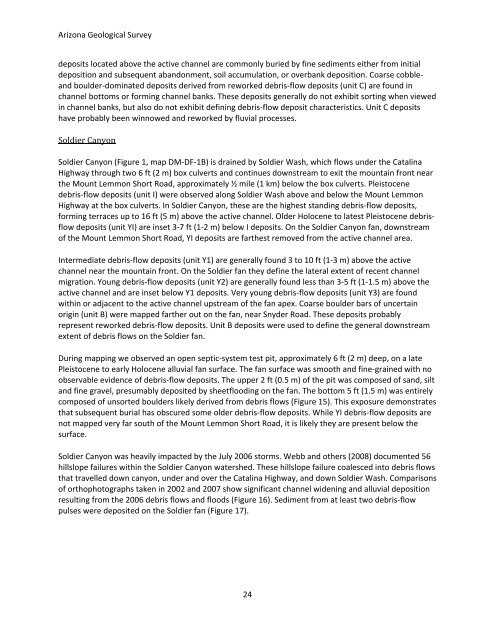Arizona Geological Survey OPEN-FILE REPORT OFR 08-06
Arizona Geological Survey OPEN-FILE REPORT OFR 08-06
Arizona Geological Survey OPEN-FILE REPORT OFR 08-06
Create successful ePaper yourself
Turn your PDF publications into a flip-book with our unique Google optimized e-Paper software.
<strong>Arizona</strong> <strong>Geological</strong> <strong>Survey</strong><br />
deposits located above the active channel are commonly buried by fine sediments either from initial<br />
deposition and subsequent abandonment, soil accumulation, or overbank deposition. Coarse cobbleand<br />
boulder‐dominated deposits derived from reworked debris‐flow deposits (unit C) are found in<br />
channel bottoms or forming channel banks. These deposits generally do not exhibit sorting when viewed<br />
in channel banks, but also do not exhibit defining debris‐flow deposit characteristics. Unit C deposits<br />
have probably been winnowed and reworked by fluvial processes.<br />
Soldier Canyon<br />
Soldier Canyon (Figure 1, map DM‐DF‐1B) is drained by Soldier Wash, which flows under the Catalina<br />
Highway through two 6 ft (2 m) box culverts and continues downstream to exit the mountain front near<br />
the Mount Lemmon Short Road, approximately ½ mile (1 km) below the box culverts. Pleistocene<br />
debris‐flow deposits (unit I) were observed along Soldier Wash above and below the Mount Lemmon<br />
Highway at the box culverts. In Soldier Canyon, these are the highest standing debris‐flow deposits,<br />
forming terraces up to 16 ft (5 m) above the active channel. Older Holocene to latest Pleistocene debrisflow<br />
deposits (unit YI) are inset 3‐7 ft (1‐2 m) below I deposits. On the Soldier Canyon fan, downstream<br />
of the Mount Lemmon Short Road, YI deposits are farthest removed from the active channel area.<br />
Intermediate debris‐flow deposits (unit Y1) are generally found 3 to 10 ft (1‐3 m) above the active<br />
channel near the mountain front. On the Soldier fan they define the lateral extent of recent channel<br />
migration. Young debris‐flow deposits (unit Y2) are generally found less than 3‐5 ft (1‐1.5 m) above the<br />
active channel and are inset below Y1 deposits. Very young debris‐flow deposits (unit Y3) are found<br />
within or adjacent to the active channel upstream of the fan apex. Coarse boulder bars of uncertain<br />
origin (unit B) were mapped farther out on the fan, near Snyder Road. These deposits probably<br />
represent reworked debris‐flow deposits. Unit B deposits were used to define the general downstream<br />
extent of debris flows on the Soldier fan.<br />
During mapping we observed an open septic‐system test pit, approximately 6 ft (2 m) deep, on a late<br />
Pleistocene to early Holocene alluvial fan surface. The fan surface was smooth and fine‐grained with no<br />
observable evidence of debris‐flow deposits. The upper 2 ft (0.5 m) of the pit was composed of sand, silt<br />
and fine gravel, presumably deposited by sheetflooding on the fan. The bottom 5 ft (1.5 m) was entirely<br />
composed of unsorted boulders likely derived from debris flows (Figure 15). This exposure demonstrates<br />
that subsequent burial has obscured some older debris‐flow deposits. While YI debris‐flow deposits are<br />
not mapped very far south of the Mount Lemmon Short Road, it is likely they are present below the<br />
surface.<br />
Soldier Canyon was heavily impacted by the July 20<strong>06</strong> storms. Webb and others (20<strong>08</strong>) documented 56<br />
hillslope failures within the Soldier Canyon watershed. These hillslope failure coalesced into debris flows<br />
that travelled down canyon, under and over the Catalina Highway, and down Soldier Wash. Comparisons<br />
of orthophotographs taken in 2002 and 2007 show significant channel widening and alluvial deposition<br />
resulting from the 20<strong>06</strong> debris flows and floods (Figure 16). Sediment from at least two debris‐flow<br />
pulses were deposited on the Soldier fan (Figure 17).<br />
24
















